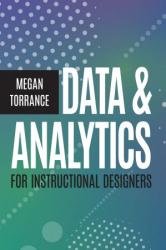Data and Analytics for Instructional Designers
- Добавил: literator
- Дата: 12-04-2023, 17:26
- Комментариев: 0
 Название: Data and Analytics for Instructional Designers
Название: Data and Analytics for Instructional DesignersАвтор: Megan Torrance
Издательство: Association for Talent Development
Год: 2023
Страниц: 228
Язык: английский
Формат: pdf, epub, mobi
Размер: 10.4 MB
Add Data and Analytics to Your TD Toolkit.
Instructional design pro Megan Torrance addresses the importance of instructional designers accessing and applying learning and performance data—from how to design learning experiences with data collection in mind to how to use the data to improve and evaluate those experiences.
With the advance of new learning technologies and data specifications, instructional designers have access to more and richer data sources than ever before. With that comes the question of what to do with the data. While most data and analytics books focus on their application for measurement and evaluation and assume a prior baseline understanding of what learning data and analytics mean, Data and Analytics for Instructional Designers delves into the foundational concepts that will enable instructional designers and L&D professionals to use data in their roles.
Split into two parts, the book first defines key data and analytics terms, data specifications, learning metrics, and statistical concepts. It then lays out a framework for using learning data for planning how to gather data and to building scale and maturity in your data operations. Megan reassures readers that basic math skills with some computer assistance is what you'll need to get going. So set aside any math anxiety!
Through a "If I can see it, I can be it" approach to learning data and analytics, the book blends practical what-is and how-to content with real-world examples and longer case studies from practitioners. Chapters conclude with opportunities for you to put these techniques to work right away, whether you are in a data-rich environment already, or whether you are just getting started and working on hypotheticals.
Data warehouses contain structured data from across the organization; we can contribute our learning data to this set. Data lakes contain less structured or completely unstructured data and may also contain learning data. This is a space that, as the movement toward big data and data-driven business decisions continues, will evolve and mature. If your organization has these tools, the teams that support them can guide you in their usage and help you decide if sending your learning and performance data to these stores would be a useful activity.
A variety of business tools exist for data analysis and visualization, drawing from the data warehouses and data lakes available to them. In some cases, these tools are integrated into the data stores; in other cases they are simply add-on software that leverages the data, but doesn’t handle the storage component. Typically the learning team at this level will adopt whatever the rest of the business is leveraging.
Make a plan for communicating about the data you have collected. Begin with your purpose and audience, then consider your message and what data visualizations you will use. Will you use spreadsheet software like Microsoft Excel or Google Sheets, the visualization functions of a learning analytics platform, or tools like Microsoft PowerBI, Tableau, Looker, or other visualization software? Give your report, dashboard, or presentation a pilot test with people who understand or share the needs of your intended audience and see how they respond to your work. Adjust accordingly.
Contents:
Скачать Data and Analytics for Instructional Designers
[related-news] [/related-news]
Внимание
Уважаемый посетитель, Вы зашли на сайт как незарегистрированный пользователь.
Мы рекомендуем Вам зарегистрироваться либо войти на сайт под своим именем.
Уважаемый посетитель, Вы зашли на сайт как незарегистрированный пользователь.
Мы рекомендуем Вам зарегистрироваться либо войти на сайт под своим именем.

